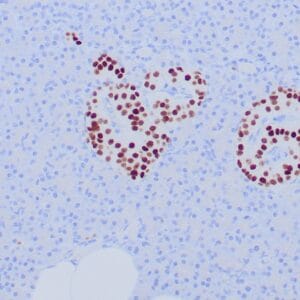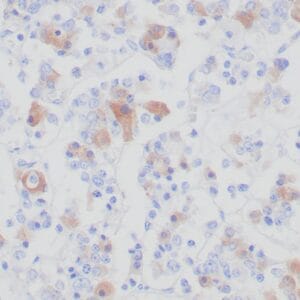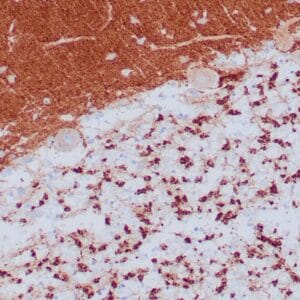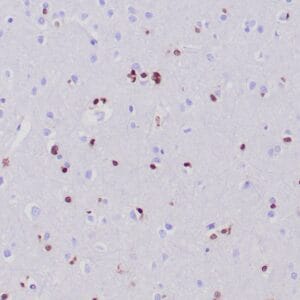| Weight | 1 lbs |
|---|---|
| Dimensions | 9 × 5 × 2 in |
| host | mouse |
| isotype | IgG |
| clonality | monoclonal |
| concentration | concentrate, predilute |
| applications | IHC |
| reactivity | human |
| available size | 0.1 mL, 0.5 mL, 1 mL concentrated, 7 mL prediluted |
rabbit anti-FOXL2 monoclonal antibody (ZR399) 6184
Price range: $160.00 through $528.00
Antibody summary
- Rabbit monoclonal to FOXL2
- Suitable for: Immunohistochemistry (formalin-fixed, paraffin-embedded tissues)
- Reacts with: Human
- Isotype:IgG
- Control: Ovarian follicular and stromal cells
- Visualization: Nucleus
- 0.1, 0.5, 1.0 mL concentrated, 7 mL prediluted
rabbit anti-FOXL2 monoclonal antibody ZR399 6184
| target relevance |
|---|
| Protein names Zinc finger E-box-binding homeobox 2 (Smad-interacting protein 1) (SMADIP1) (Zinc finger homeobox protein 1b) |
| Gene names ZEB2,ZEB2 KIAA0569 SIP1 ZFHX1B ZFX1B HRIHFB2411 |
| Protein family Delta-EF1/ZFH-1 C2H2-type zinc-finger family |
| Mass 136447Da |
| Function FUNCTION: Transcriptional inhibitor that binds to DNA sequence 5'-CACCT-3' in different promoters (PubMed:16061479, PubMed:20516212). Represses transcription of E-cadherin (PubMed:16061479). Represses expression of MEOX2 (PubMed:20516212). {ECO:0000269|PubMed:16061479, ECO:0000269|PubMed:20516212}. |
| Subellular location SUBCELLULAR LOCATION: Nucleus {ECO:0000269|PubMed:16061479, ECO:0000269|PubMed:9853615}. Chromosome {ECO:0000269|PubMed:20516212}. |
| Structure SUBUNIT: Binds activated SMAD1, activated SMAD2 and activated SMAD3; binding with SMAD4 is not detected (By similarity). Interacts with CBX4 and CTBP1. {ECO:0000250, ECO:0000269|PubMed:16061479}. |
| Post-translational modification PTM: Sumoylation on Lys-391 and Lys-866 is promoted by the E3 SUMO-protein ligase CBX4, and impairs interaction with CTBP1 and transcription repression activity. {ECO:0000269|PubMed:16061479}. |
| Involvement in disease DISEASE: Mowat-Wilson syndrome (MOWS) [MIM:235730]: A complex developmental disorder characterized by intellectual disability, delayed motor development, epilepsy, microcephaly and a wide spectrum of clinically heterogeneous features suggestive of neurocristopathies at the cephalic, cardiac, and vagal levels. Affected patients show an easily recognizable facial appearance with deep set eyes and hypertelorism, medially divergent, broad eyebrows, prominent columella, pointed chin and uplifted, notched ear lobes. Some patients manifest Hirschsprung disease. {ECO:0000269|PubMed:11448942, ECO:0000269|PubMed:12451214, ECO:0000269|PubMed:15384097, ECO:0000269|PubMed:16688751}. Note=The disease is caused by variants affecting the gene represented in this entry. |
| Target Relevance information above includes information from UniProt accession: O60315 |
| The UniProt Consortium |
Data
 |
| Formalin-fixed, paraffin-embedded human adult granulosa cell tumor stained with anti-FOXL2 antibody using peroxidase-conjugate and DAB chromogen. Note nuclear staining of tumor cells |
Publications
| pmid | title | authors | citation |
|---|---|---|---|
| We haven't added any publications to our database yet. | |||
Protocols
| relevant to this product |
|---|
| IHC |
Documents
| # | SDS | Certificate | |
|---|---|---|---|
| Please enter your product and batch number here to retrieve product datasheet, SDS, and QC information. | |||
Only logged in customers who have purchased this product may leave a review.















Reviews
There are no reviews yet.